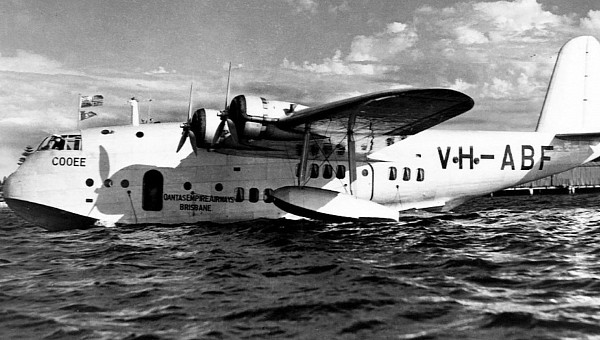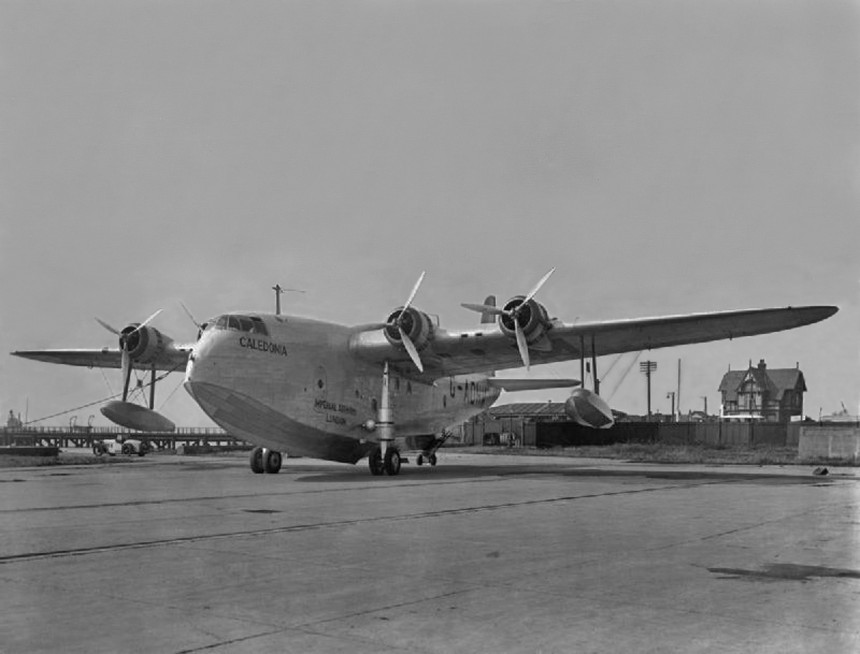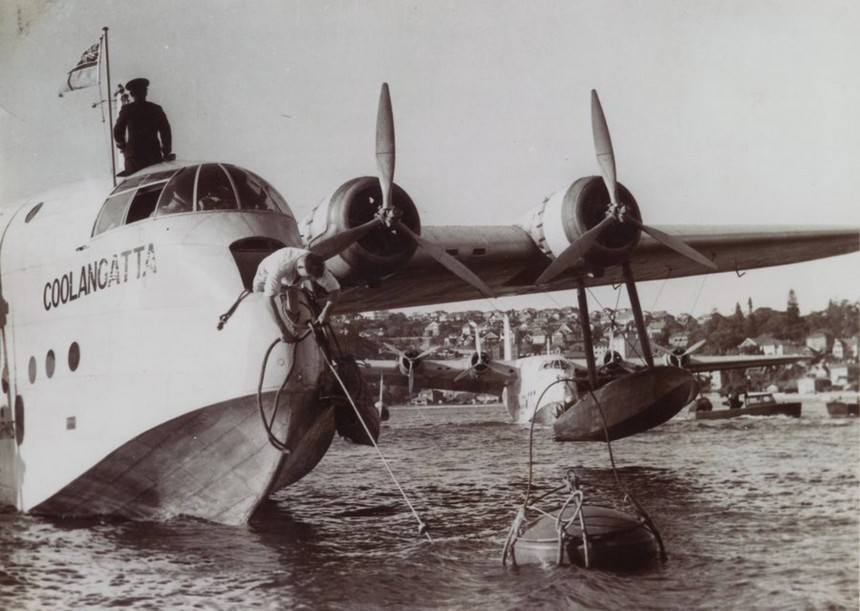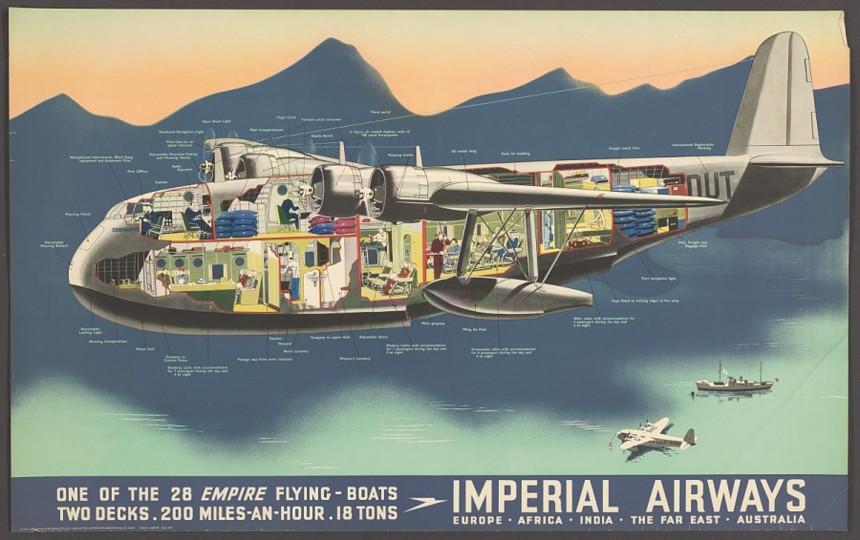Before the outbreak of the second world war, the British could still ostensibly consider themselves the world's pre-eminent power. The country that pound for pound influenced the global goings-on more than France, Germany, the Soviets, and yes, even the U.S. But by the mid-1930s, cracks were starting to show in the once impenetrable armor of what was once the world's largest empire. Their aviation sector had some serious foreign competition.
In the pre-war airliner sector, the Short Empire could still lay claim to being one of the most comfortable, luxurious, fastest, and downright fabulous ways to fly. A quad-engined flying boat that essentially acted like a transcontinental bullet train because that's roughly the same speed this slab of Northern Irish beef flew at.
At a time when airliners were filling the skies like mad, the Empire helped set the standard that American companies like Boeing and Glenn. L Martin aspired to match, not the other way around like we're all used to. At least, that's in terms of luxury. Accident history is a completely different story. To understand the impetus for the Short Empire's creation, we need to understand what it was like to live in the British Empire in the late 1930s.
By this point, most of Ireland had already told the British Monarchy to go take a hike. Not like that led to anything awful ever (not). Australia and New Zealand had also long since been on their own way before this point, with demonstrably less violence in those instances. But more to the point, there was still considerable territory in places like Africa, the Caribbean, and India, remaining within British influence and many others besides that people from Britain needed to travel back and forth from.
Enter the Short Brothers Company, an aerospace manufacturer that may have started life in the Battersea district of London but ultimately made its name in scrappy, loveable Belfast. After spending the First World War building seaplanes like the Type 184 torpedo bomber, the company was well-suited to the flying boat-friendly atmosphere of the interwar airliner sector.
Early contenders like the Short Kent and Calcutta biplanes may have been fairly luxurious for the day. But there was a sense these bi-winged ocean liners in the sky were totally last week by the turn of the 30s. It's here where we meet the second party in the Short Empire affair, Imperial Airways. Better known to most people as the predecessor group to British Overseas Airline Corporation, Imperial Airways was one of the go-to means of traveling the British colonies in the mid to late 1920s.
Once difficult aerial jaunts like London to Calcutta and London to Rangoon became a near routine for Imperial around this time. What they required was a four-engined, ultra-luxurious, mono-wing flying boat airliner that made the journey just that little bit faster and smoother.
What's the other aircraft type that pairs well with four engines? That'd be strategic bombers. As it happens, the Short Empire was developed in parallel with the Sunderland bomber. The extra Royal Air Force funding was no doubt a huge help in the whole affair.
The finished Empire airliner left Short's Belfast factory and took to the skies for the first time on July 3rd, 1936. From day one, the design work of the Empire's lead engineer Sir Arthur Gouge was a cut above what the company had built before. Configurations that were designed for passenger service featured bespoke cabins fore and aft with comfortable, stitched leather-clad and adjustable seats.
But what is it that British aristocrats loved to do more than anything else on overseas jaunts to the colonies? That'd be smoking, of course. That's why a portion of the forward fuselage in front of the two passenger compartments was dedicated to a cigar lounge with a capacity for six occupants during the day and four at night. You best believe the champagne was flowing throughout the aircraft during these overseas trips.
Flights aboard Short Empires were often accompanied by up to 1.5 tons of mail. In a time before long-haul trucks could haul similar loads of mail, this was no small amount. There was even a spot on the crew rotation for a mail clerk whose only job was to catalog all the mail before it reached its relay at the end of the flight. Laden with up to 24 passengers plus all the mail, the Empire flying boat tipped the scales at 40,500 lbs (18,370 kg).
Prohibition was already a thing of the past by 1936, so even American travelers returning to the States on Short Empires could join in on the fun when they reached their destination. Powering these 88-foot (26.82 m) long beast were four 28-liter (1,750-cubic inch) Bristol Pegasus nine-cylinder air-cooled radial engines. In their initial configuration for the Short Empire, these engines produced 920 horsepower.
This equated to a cruising speed in the region of 170 mph (273.5 kph). With a fair tailwind behind it, the old beast could muster a top speed of 200 mph (321.8 kph). In numbers common folks can appreciate, this speed meant trips like New York to London or vice versa could be completed in just 12 hours. Keep in mind this is in the late 1930s. It sure beats a cramped passenger ship you can't disembark for at least a few weeks.
In gallivants to far-off places like Cairo, Egypt, the Short Empire operated as an ambassador of sorts as it looked to maintain its influence in North Africa and the Middle East. On routes to New York City, Empires would float across the paths of its American rivals like the Sikorsky S-42s, Boeing 314s, and Martin China Clippers in service with Imperial airways rivals like Pan Am.
If not for having more pilot error-related mishaps and accidents than most would be comfortable with, the Empire would have been the crown jewel of flying boat airliners in service at the time. Thicker gauges of steel in the shipper undercarriage and hull, along with sleeve valve mechanisms instead of poppet valves, made subsequent models of the Empire, codename S.30s and S.33s, more reliable and sturdy than early models, codename S.23s.
At the onset of the start of the Second World War, Short Empires joined their Sunderland bomber cousins in service with the RAF over Europe. While Sunderlands dropped up to 2,000 lbs (907.1 kg) of bombs or depth charges, Empires became dedicated military cargo planes and submarine hunters. Some were even equipped with gun turret pods. After the war, newly built Army and Air Force runways in Britain made the need for water-based airliners far less of a priority.
The last transatlantic jaunt by a Short Empire took place in 1940. By 1947, the type was out of service entirely. But not before the type saw considerable service with airlines in Britain, New Zealand, and Australia. From then on, British aircraft in both the civil and military sectors were due to take back seats at the hands of superior American technology. But for a few fleeting moments, the airliner space among the soon-to-be Allied nations had a top rising star with a union jack across its bow.
Check back real soon for more vintage aviation profiles right here on autoevolution.
At a time when airliners were filling the skies like mad, the Empire helped set the standard that American companies like Boeing and Glenn. L Martin aspired to match, not the other way around like we're all used to. At least, that's in terms of luxury. Accident history is a completely different story. To understand the impetus for the Short Empire's creation, we need to understand what it was like to live in the British Empire in the late 1930s.
By this point, most of Ireland had already told the British Monarchy to go take a hike. Not like that led to anything awful ever (not). Australia and New Zealand had also long since been on their own way before this point, with demonstrably less violence in those instances. But more to the point, there was still considerable territory in places like Africa, the Caribbean, and India, remaining within British influence and many others besides that people from Britain needed to travel back and forth from.
Enter the Short Brothers Company, an aerospace manufacturer that may have started life in the Battersea district of London but ultimately made its name in scrappy, loveable Belfast. After spending the First World War building seaplanes like the Type 184 torpedo bomber, the company was well-suited to the flying boat-friendly atmosphere of the interwar airliner sector.
Once difficult aerial jaunts like London to Calcutta and London to Rangoon became a near routine for Imperial around this time. What they required was a four-engined, ultra-luxurious, mono-wing flying boat airliner that made the journey just that little bit faster and smoother.
What's the other aircraft type that pairs well with four engines? That'd be strategic bombers. As it happens, the Short Empire was developed in parallel with the Sunderland bomber. The extra Royal Air Force funding was no doubt a huge help in the whole affair.
The finished Empire airliner left Short's Belfast factory and took to the skies for the first time on July 3rd, 1936. From day one, the design work of the Empire's lead engineer Sir Arthur Gouge was a cut above what the company had built before. Configurations that were designed for passenger service featured bespoke cabins fore and aft with comfortable, stitched leather-clad and adjustable seats.
Flights aboard Short Empires were often accompanied by up to 1.5 tons of mail. In a time before long-haul trucks could haul similar loads of mail, this was no small amount. There was even a spot on the crew rotation for a mail clerk whose only job was to catalog all the mail before it reached its relay at the end of the flight. Laden with up to 24 passengers plus all the mail, the Empire flying boat tipped the scales at 40,500 lbs (18,370 kg).
Prohibition was already a thing of the past by 1936, so even American travelers returning to the States on Short Empires could join in on the fun when they reached their destination. Powering these 88-foot (26.82 m) long beast were four 28-liter (1,750-cubic inch) Bristol Pegasus nine-cylinder air-cooled radial engines. In their initial configuration for the Short Empire, these engines produced 920 horsepower.
This equated to a cruising speed in the region of 170 mph (273.5 kph). With a fair tailwind behind it, the old beast could muster a top speed of 200 mph (321.8 kph). In numbers common folks can appreciate, this speed meant trips like New York to London or vice versa could be completed in just 12 hours. Keep in mind this is in the late 1930s. It sure beats a cramped passenger ship you can't disembark for at least a few weeks.
In gallivants to far-off places like Cairo, Egypt, the Short Empire operated as an ambassador of sorts as it looked to maintain its influence in North Africa and the Middle East. On routes to New York City, Empires would float across the paths of its American rivals like the Sikorsky S-42s, Boeing 314s, and Martin China Clippers in service with Imperial airways rivals like Pan Am.
At the onset of the start of the Second World War, Short Empires joined their Sunderland bomber cousins in service with the RAF over Europe. While Sunderlands dropped up to 2,000 lbs (907.1 kg) of bombs or depth charges, Empires became dedicated military cargo planes and submarine hunters. Some were even equipped with gun turret pods. After the war, newly built Army and Air Force runways in Britain made the need for water-based airliners far less of a priority.
The last transatlantic jaunt by a Short Empire took place in 1940. By 1947, the type was out of service entirely. But not before the type saw considerable service with airlines in Britain, New Zealand, and Australia. From then on, British aircraft in both the civil and military sectors were due to take back seats at the hands of superior American technology. But for a few fleeting moments, the airliner space among the soon-to-be Allied nations had a top rising star with a union jack across its bow.
Check back real soon for more vintage aviation profiles right here on autoevolution.










